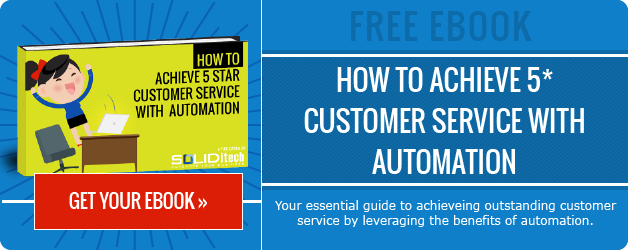To start reading this article, press 1.
To skip to the conclusion, press 2.
To speak to a customer service representative, press 3.
You pressed 3, goodbye. Click. Beeeeeeep…
We’ve all been through it. Your internet is giving you issues, so you check your provider's website and there’s nothing on there, so you ring up the call centre....
You call expecting the best – an actual human (a friendly one) to pick up instantly and solve all your issues... Enter IVR, CTI and other Customer Service Automation solutions.
And here lies the downside to automating any part of your business. You may be saving money by minimising your costs, but the cost of annoying and losing even just one customer is costing your business even more.
CEO of cloud telephony company Knowlarity, Ambarish Gupta notes that, “When IVR does not lead to consumer satisfaction and quick resolutions, it is very likely that the customer will turn to a competitor for the same service" (source: FIN24).
So, what are the biggest frustrations that cause customers to switch providers and how can you rectify these issues for your own company? Here are some issues and answers that can be put in place to create an effective, efficient, and speedy automation system (that doesn’t annoy your customers).
Issue 1: Long process to get to an answer
There is an issue with your banking app. Whenever you turn it on, it instantly shuts down. You send an email to customer support and receive a generic, robotic auto-response.
But you need an answer now, so you call the customer care line.
The automated message asks you to press specific buttons for certain problems, but your issue is not on the list. After waiting for some time, the line goes dead. You call again and press any button hoping to get to an actual human being. After many prompts you finally get there. A customer care representative answers the phone. You start answering the security question, “My ID number is 831205… hello? Hello?” Your airtime has run out.
Solutions:
The aim of your automation system should not be to answer all queries.
The goal of automation should be to quickly guide your customer to the right answer. If it cannot, a customer service representative should be available.
One example is marketing aficionados Hubspot and their Help function. They use a funnelling process, where their automation system allows the user to get to their answers quickly. They ask the user a broad question, “Do you mean a or b?” Customer clicks a. Then Hubspot asks a more refined question, “Do you mean c or d?” Customer clicks on d, and so on. In this way, customers get to their answers hassle-free without once interacting with a human being. If they cannot find their answer, Hubspot asks if they would like to contact support via email or a call back. Simple, easy to navigate and actually fun to use!
Automation should therefore be used as a starting point, not an end goal.
Brian Gladu in an article for Groove writes a simple yet effective rule of thumb, “Automate processes. Do not automate relationships”.
Use automation to start the conversation and get the ball rolling, not to try to act in place of a person.In an article for Smashing Magazine, Matthew Guay writes, “Automated emails are good for things that robots [or automation] do best: extending trials, confirming appointments, sending license keys and other things for which you would merely have to look up and copy data.” Leave the stuff that robots do best for the robots, the humans can handle the rest.
Response times should be quick and answers should be obtained with little hassle.
Let your automated systems focus on answering broad queries. And then let the customer funnel into the answer they need, like the Hubspot example. Trawling through mechanical responses in an infinite feedback loop is a sure fire way to lose customers. One way to handle long waits is to provide the option of calling the customer back without losing their place in the queue, i.e. automated call backs.
What are automated call back systems?Callcenterhelper.com describes these systems in the following way: “Call back technology is a strategic tool for contact centres – a weapon in beating the stereotype of lengthy contact centre waits. Rather than being kept on hold – consistently the biggest cause of dissatisfaction for callers – an automated call back system gives customers the option of hanging up and being contacted later in the day. Customers can hold their place in the queue without having to actually wait on the phone. The ‘call back’ will either be as soon as an agent is free or during an allotted timeframe later that day. This technology helps contact centres level out peaks in calls during the day, provide a better quality of service for customers and use agents’ time more effectively. Indeed, in research by the Future Foundation commissioned by Netcall, 97% of contact centre customers stated that more contact centres should offer call back technology. Furthermore, 93% of agents commented that this functionality made their job easier.” |
Issue 2: It takes forever for the company to figure out who you are
Every time you contact customer services, you have to go through a long list of typing in or stating your personal details, so that they can find out who you are and where you belong on their database. After doing this too many times you start to feel that you are not a unique customer, but rather a cog in a system of millions of other customers. You may lie back on the sofa in anguish, whispering to yourself “Who am I?” and “Do I even actually matter to this company?” Your existential woes should not be geared to customer services.
Solutions:
Build a core database of information.
This is where all data is available in an easily searchable system. All the customer’s information is then available at your fingertips, in one place. You can also supply the customer with a unique Id. When they log into the system, they can just type in this Id and all their information appears.
Integrate all devices to a single database.
A large majority of your customers will most probably have a smartphone, right? Put this to use by integrating their mobile applications with your database. Allow for various modes of connectivity that permit automated operations where customers can generate support tickets and get a call back. Think of Google Apps, you only have to log on once and all your information is in one location and easily accessible from any device. #best, right?
Issue 3: Lacking that personal touch
You type a very heartfelt email explaining a deeply personal issue about why you could not make a payment and ask for your available options. You receive a static, impersonal response from a machine asking you to visit the FAQ section on their website. Then you call the customer care line, as your question is not frequently asked. After waiting 30 minutes, you get through to a very bland and unmotivated representative that puts you on hold for another 10 minutes. While you wait, the sound of a terrible rendition of some pop song starts draining your energy. It would be easier just to quit and not make the payment until they contact you, wouldn’t it?
Solutions:
Create fun, interactive but genuine auto-responses.
Don’t try to hide the fact that your response is automated, but do create a message that notifies your customer that the email or message being sent is important and that they can respond to an actual person if need be. A company named FullContact, for example, have changed their domain name from noreply@fullcontact to pleasereply@fullcontact.
Make your customers feel important.
Existing customers are important. Global firm, Lee Resource Inc., conducted a study and they came to the conclusion that retaining existing customers costs five times less than attracting new customers (Source: Forbes). Once the customer logs on, use personalised tokens to make them feel special, i.e. by welcoming them back or asking if they need any help. A simple, “How can we help you today?”, with an image of an actual support staff member that is contactable can go a long way (please, no stock images here). It will make your automation system seem like less of a robot and more human.
Issue 4: Not focusing on what automation does right
You try loading a piece of software. You wait for ten minutes into the installation process: 97 percent, 98, 99… and an error occurs. You try the installation process again. You shut down your machine, power it back on and try one more time. The same error occurs. You have just wasted an hour of your time trying to install software that should work. You trawl the internet for answers – blogs, forums, prayers – but nothing seems to work. Now is the time to put in the effort to contact customer services.
Solution:
Decide what automation does well.
Simply put, automation is great at doing the things that humans can’t. Like what you may ask? Well, a variety of things, for example, respond to real time customer stress singles at lightning speed. A customer usually has to make an effort to rectify a situation. They need to proactively reach out for human support. What automation does well is to instantly react to stress indicators. Automation systems can see which customers have been repeatedly visiting the same help documents.
After monitoring user’s information it notes stress signals and instantly reaches out to customers - something that would take forever for human beings to do. Predicting customer irritation and being proactive can lessen customer churn. And remember, if the customer throws in the towel with your company, they may relay this negative experience to friends and family.
As mentioned above, the aim of automation is not to take over human interaction completely, but rather to guide the customer in the right direction to an answer – i.e. if that answer is not available to a human touch point. Your goal in using an automated system is therefore to find the right mix between human contact and automation. If the automation system provides extra value to your customer, use it. If not, discard it!
For more information about how you can leverage automation to aid towards your customer service efforts, read this post.








Comment